Gender Inequality in the Workplace
VerifiedAdded on 2023/06/03
|14
|3803
|294
AI Summary
This article discusses the issue of gender inequality in the workplace, its adverse effects on female employees, and advocacy for gender equality in Australia. It also highlights the various legislations passed by the national government to mitigate this issue.
Contribute Materials
Your contribution can guide someone’s learning journey. Share your
documents today.
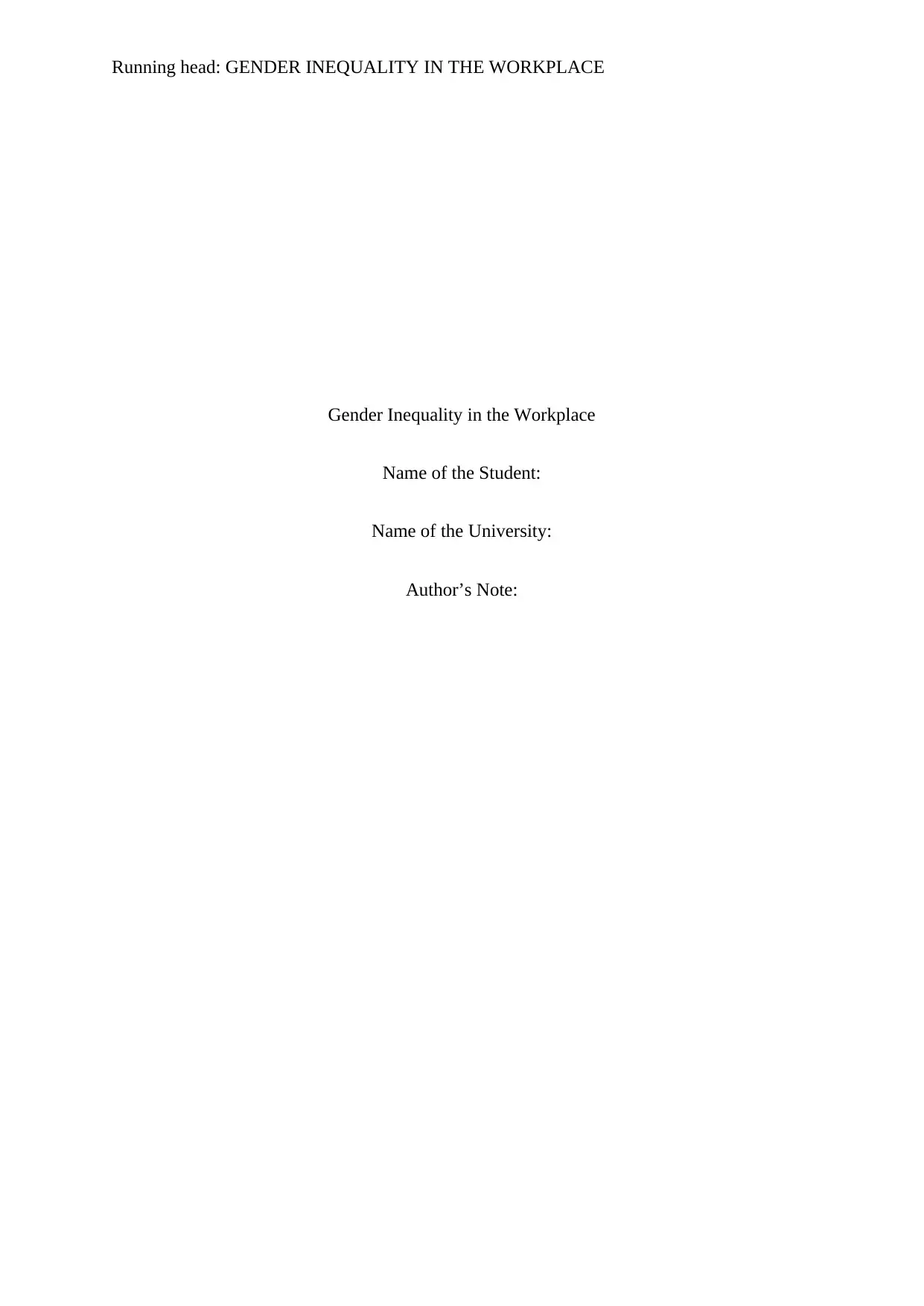
Running head: GENDER INEQUALITY IN THE WORKPLACE
Gender Inequality in the Workplace
Name of the Student:
Name of the University:
Author’s Note:
Gender Inequality in the Workplace
Name of the Student:
Name of the University:
Author’s Note:
Secure Best Marks with AI Grader
Need help grading? Try our AI Grader for instant feedback on your assignments.
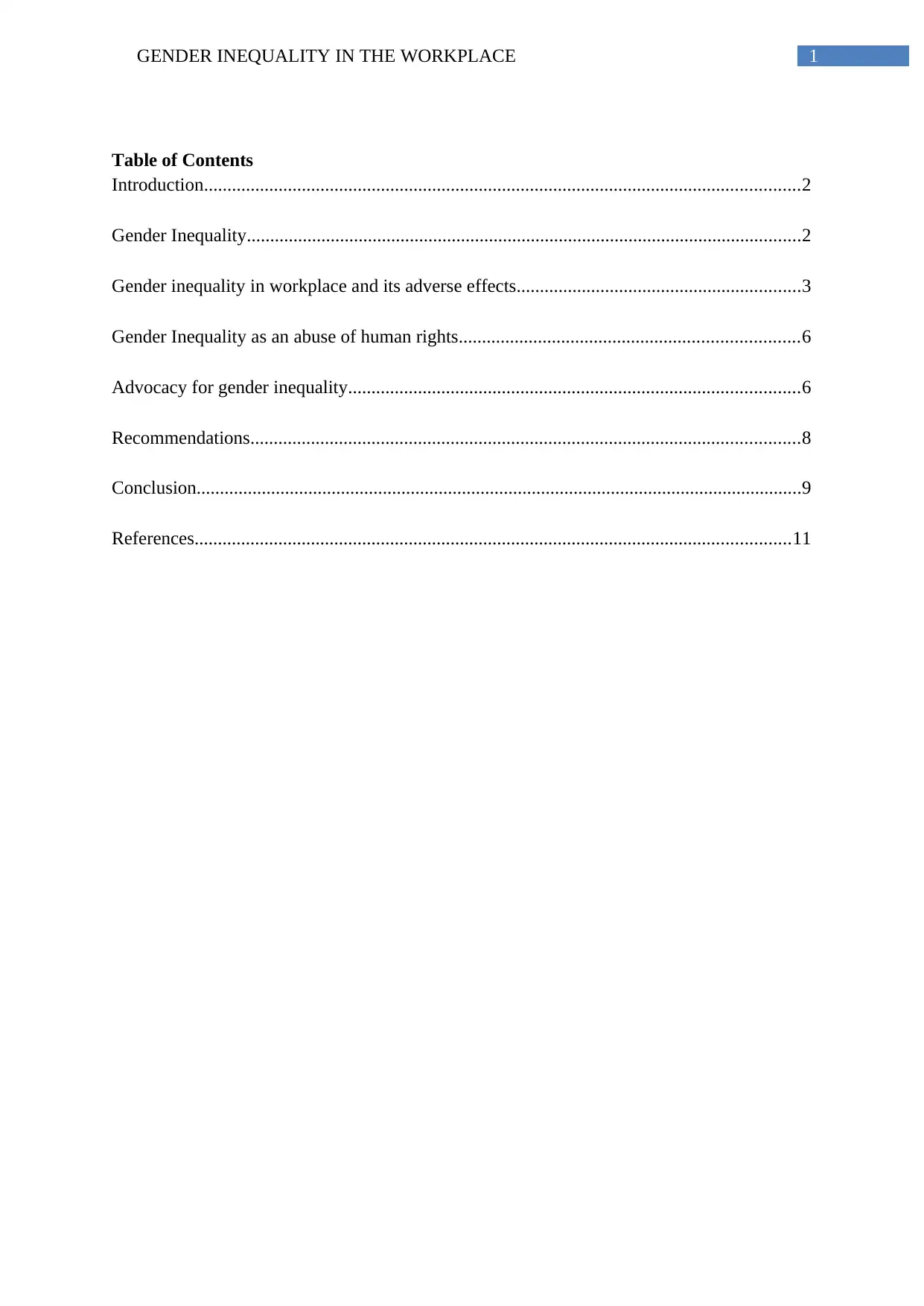
1GENDER INEQUALITY IN THE WORKPLACE
Table of Contents
Introduction................................................................................................................................2
Gender Inequality.......................................................................................................................2
Gender inequality in workplace and its adverse effects.............................................................3
Gender Inequality as an abuse of human rights.........................................................................6
Advocacy for gender inequality.................................................................................................6
Recommendations......................................................................................................................8
Conclusion..................................................................................................................................9
References................................................................................................................................11
Table of Contents
Introduction................................................................................................................................2
Gender Inequality.......................................................................................................................2
Gender inequality in workplace and its adverse effects.............................................................3
Gender Inequality as an abuse of human rights.........................................................................6
Advocacy for gender inequality.................................................................................................6
Recommendations......................................................................................................................8
Conclusion..................................................................................................................................9
References................................................................................................................................11
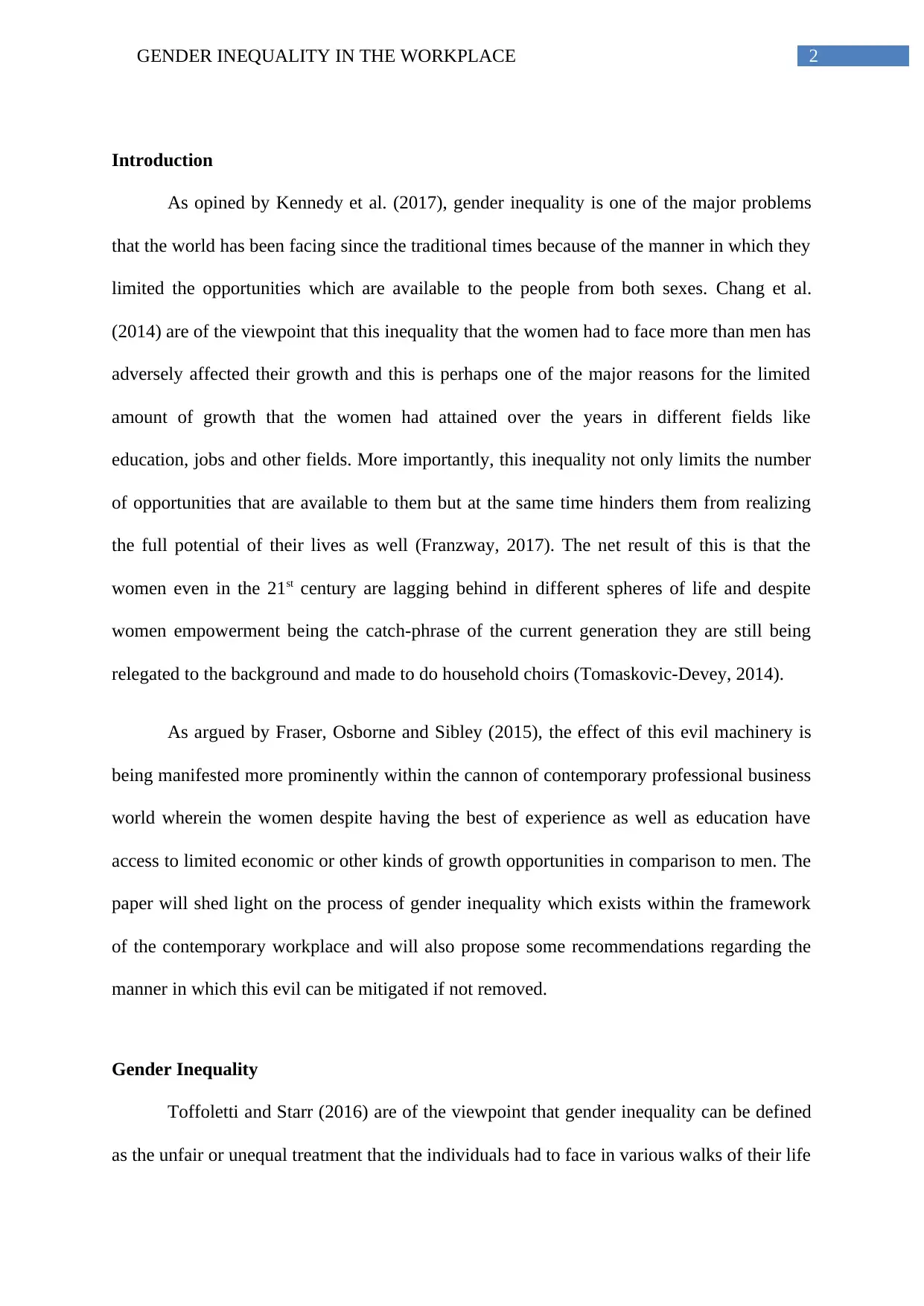
2GENDER INEQUALITY IN THE WORKPLACE
Introduction
As opined by Kennedy et al. (2017), gender inequality is one of the major problems
that the world has been facing since the traditional times because of the manner in which they
limited the opportunities which are available to the people from both sexes. Chang et al.
(2014) are of the viewpoint that this inequality that the women had to face more than men has
adversely affected their growth and this is perhaps one of the major reasons for the limited
amount of growth that the women had attained over the years in different fields like
education, jobs and other fields. More importantly, this inequality not only limits the number
of opportunities that are available to them but at the same time hinders them from realizing
the full potential of their lives as well (Franzway, 2017). The net result of this is that the
women even in the 21st century are lagging behind in different spheres of life and despite
women empowerment being the catch-phrase of the current generation they are still being
relegated to the background and made to do household choirs (Tomaskovic-Devey, 2014).
As argued by Fraser, Osborne and Sibley (2015), the effect of this evil machinery is
being manifested more prominently within the cannon of contemporary professional business
world wherein the women despite having the best of experience as well as education have
access to limited economic or other kinds of growth opportunities in comparison to men. The
paper will shed light on the process of gender inequality which exists within the framework
of the contemporary workplace and will also propose some recommendations regarding the
manner in which this evil can be mitigated if not removed.
Gender Inequality
Toffoletti and Starr (2016) are of the viewpoint that gender inequality can be defined
as the unfair or unequal treatment that the individuals had to face in various walks of their life
Introduction
As opined by Kennedy et al. (2017), gender inequality is one of the major problems
that the world has been facing since the traditional times because of the manner in which they
limited the opportunities which are available to the people from both sexes. Chang et al.
(2014) are of the viewpoint that this inequality that the women had to face more than men has
adversely affected their growth and this is perhaps one of the major reasons for the limited
amount of growth that the women had attained over the years in different fields like
education, jobs and other fields. More importantly, this inequality not only limits the number
of opportunities that are available to them but at the same time hinders them from realizing
the full potential of their lives as well (Franzway, 2017). The net result of this is that the
women even in the 21st century are lagging behind in different spheres of life and despite
women empowerment being the catch-phrase of the current generation they are still being
relegated to the background and made to do household choirs (Tomaskovic-Devey, 2014).
As argued by Fraser, Osborne and Sibley (2015), the effect of this evil machinery is
being manifested more prominently within the cannon of contemporary professional business
world wherein the women despite having the best of experience as well as education have
access to limited economic or other kinds of growth opportunities in comparison to men. The
paper will shed light on the process of gender inequality which exists within the framework
of the contemporary workplace and will also propose some recommendations regarding the
manner in which this evil can be mitigated if not removed.
Gender Inequality
Toffoletti and Starr (2016) are of the viewpoint that gender inequality can be defined
as the unfair or unequal treatment that the individuals had to face in various walks of their life
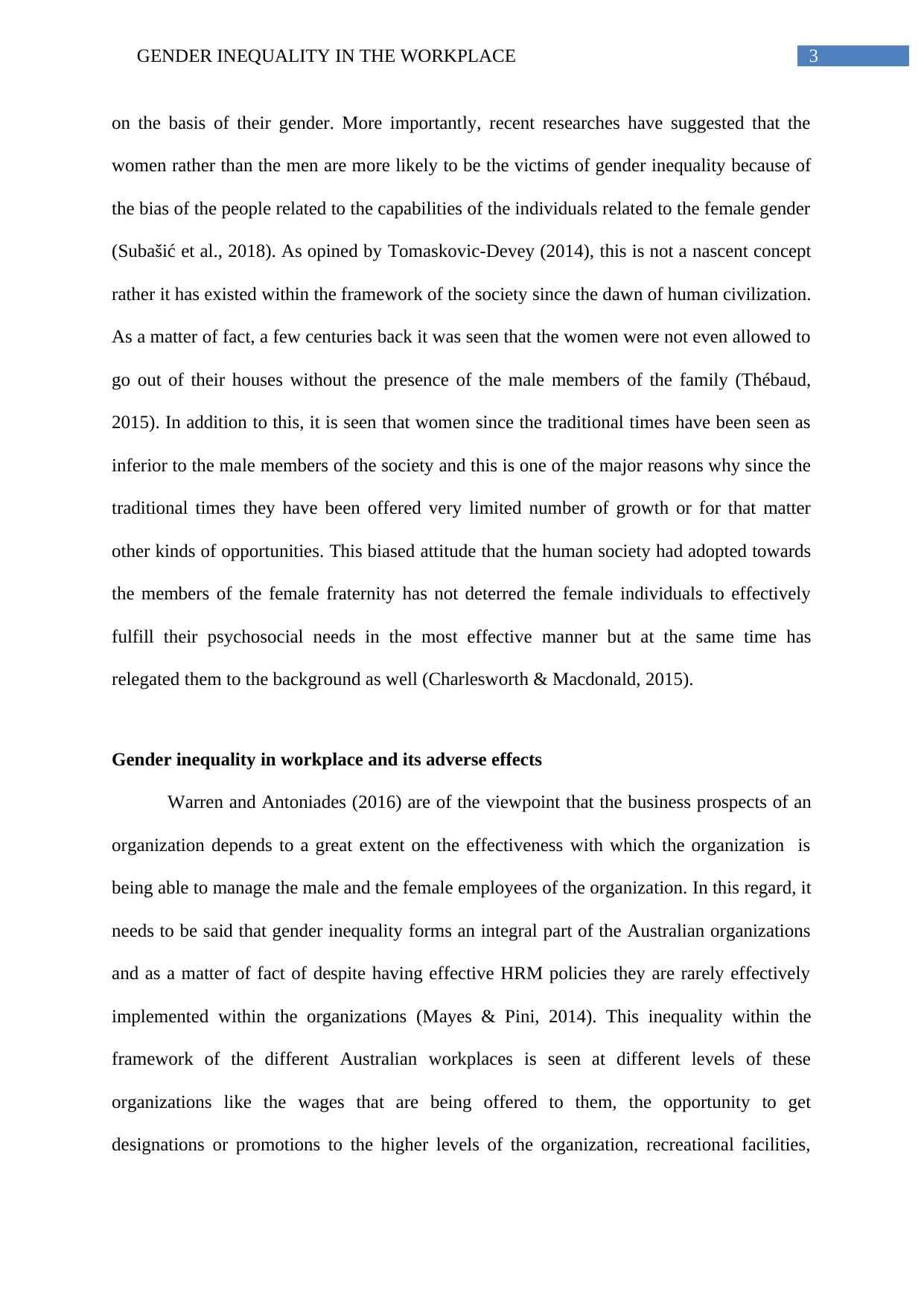
3GENDER INEQUALITY IN THE WORKPLACE
on the basis of their gender. More importantly, recent researches have suggested that the
women rather than the men are more likely to be the victims of gender inequality because of
the bias of the people related to the capabilities of the individuals related to the female gender
(Subašić et al., 2018). As opined by Tomaskovic-Devey (2014), this is not a nascent concept
rather it has existed within the framework of the society since the dawn of human civilization.
As a matter of fact, a few centuries back it was seen that the women were not even allowed to
go out of their houses without the presence of the male members of the family (Thébaud,
2015). In addition to this, it is seen that women since the traditional times have been seen as
inferior to the male members of the society and this is one of the major reasons why since the
traditional times they have been offered very limited number of growth or for that matter
other kinds of opportunities. This biased attitude that the human society had adopted towards
the members of the female fraternity has not deterred the female individuals to effectively
fulfill their psychosocial needs in the most effective manner but at the same time has
relegated them to the background as well (Charlesworth & Macdonald, 2015).
Gender inequality in workplace and its adverse effects
Warren and Antoniades (2016) are of the viewpoint that the business prospects of an
organization depends to a great extent on the effectiveness with which the organization is
being able to manage the male and the female employees of the organization. In this regard, it
needs to be said that gender inequality forms an integral part of the Australian organizations
and as a matter of fact of despite having effective HRM policies they are rarely effectively
implemented within the organizations (Mayes & Pini, 2014). This inequality within the
framework of the different Australian workplaces is seen at different levels of these
organizations like the wages that are being offered to them, the opportunity to get
designations or promotions to the higher levels of the organization, recreational facilities,
on the basis of their gender. More importantly, recent researches have suggested that the
women rather than the men are more likely to be the victims of gender inequality because of
the bias of the people related to the capabilities of the individuals related to the female gender
(Subašić et al., 2018). As opined by Tomaskovic-Devey (2014), this is not a nascent concept
rather it has existed within the framework of the society since the dawn of human civilization.
As a matter of fact, a few centuries back it was seen that the women were not even allowed to
go out of their houses without the presence of the male members of the family (Thébaud,
2015). In addition to this, it is seen that women since the traditional times have been seen as
inferior to the male members of the society and this is one of the major reasons why since the
traditional times they have been offered very limited number of growth or for that matter
other kinds of opportunities. This biased attitude that the human society had adopted towards
the members of the female fraternity has not deterred the female individuals to effectively
fulfill their psychosocial needs in the most effective manner but at the same time has
relegated them to the background as well (Charlesworth & Macdonald, 2015).
Gender inequality in workplace and its adverse effects
Warren and Antoniades (2016) are of the viewpoint that the business prospects of an
organization depends to a great extent on the effectiveness with which the organization is
being able to manage the male and the female employees of the organization. In this regard, it
needs to be said that gender inequality forms an integral part of the Australian organizations
and as a matter of fact of despite having effective HRM policies they are rarely effectively
implemented within the organizations (Mayes & Pini, 2014). This inequality within the
framework of the different Australian workplaces is seen at different levels of these
organizations like the wages that are being offered to them, the opportunity to get
designations or promotions to the higher levels of the organization, recreational facilities,
Secure Best Marks with AI Grader
Need help grading? Try our AI Grader for instant feedback on your assignments.
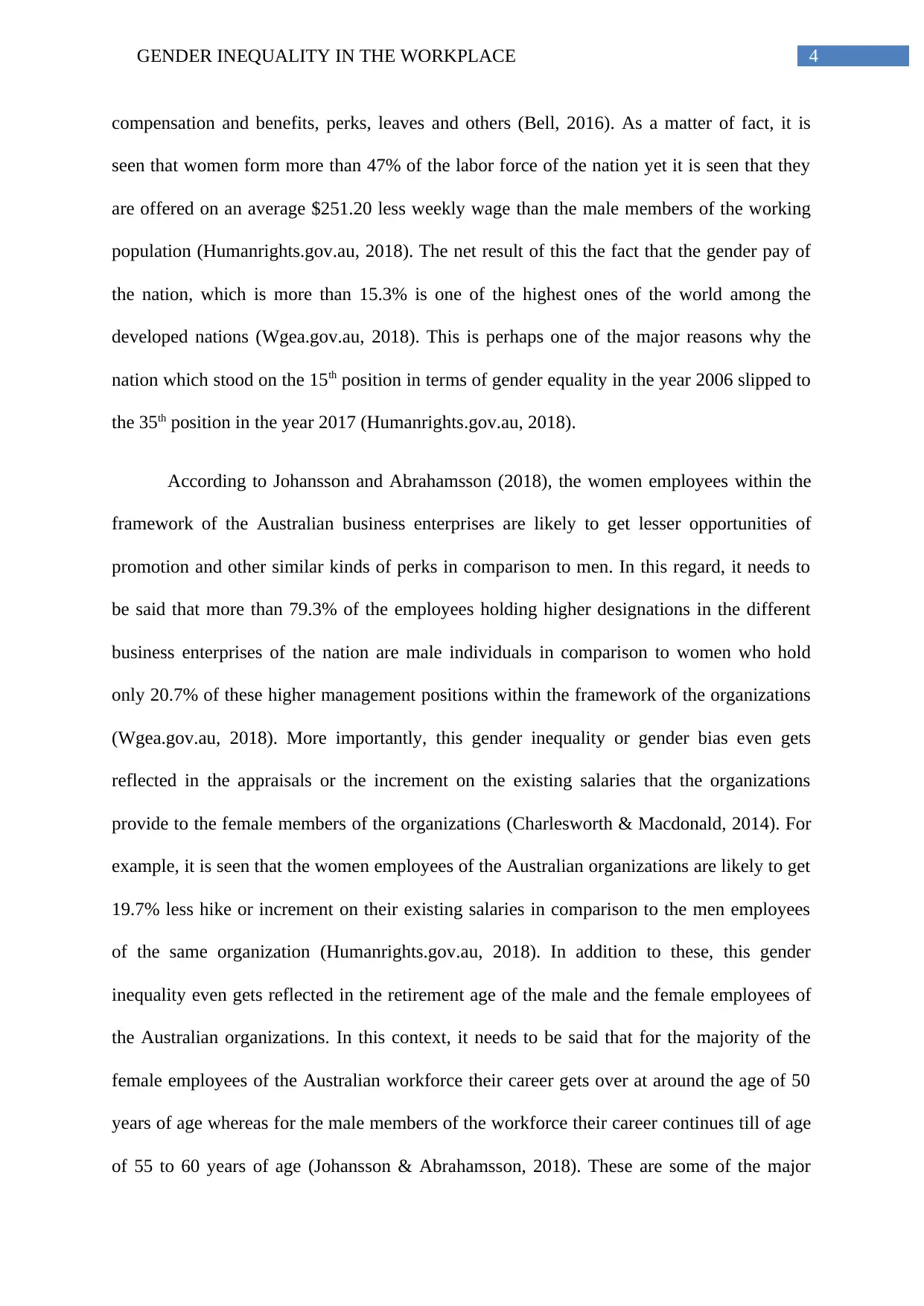
4GENDER INEQUALITY IN THE WORKPLACE
compensation and benefits, perks, leaves and others (Bell, 2016). As a matter of fact, it is
seen that women form more than 47% of the labor force of the nation yet it is seen that they
are offered on an average $251.20 less weekly wage than the male members of the working
population (Humanrights.gov.au, 2018). The net result of this the fact that the gender pay of
the nation, which is more than 15.3% is one of the highest ones of the world among the
developed nations (Wgea.gov.au, 2018). This is perhaps one of the major reasons why the
nation which stood on the 15th position in terms of gender equality in the year 2006 slipped to
the 35th position in the year 2017 (Humanrights.gov.au, 2018).
According to Johansson and Abrahamsson (2018), the women employees within the
framework of the Australian business enterprises are likely to get lesser opportunities of
promotion and other similar kinds of perks in comparison to men. In this regard, it needs to
be said that more than 79.3% of the employees holding higher designations in the different
business enterprises of the nation are male individuals in comparison to women who hold
only 20.7% of these higher management positions within the framework of the organizations
(Wgea.gov.au, 2018). More importantly, this gender inequality or gender bias even gets
reflected in the appraisals or the increment on the existing salaries that the organizations
provide to the female members of the organizations (Charlesworth & Macdonald, 2014). For
example, it is seen that the women employees of the Australian organizations are likely to get
19.7% less hike or increment on their existing salaries in comparison to the men employees
of the same organization (Humanrights.gov.au, 2018). In addition to these, this gender
inequality even gets reflected in the retirement age of the male and the female employees of
the Australian organizations. In this context, it needs to be said that for the majority of the
female employees of the Australian workforce their career gets over at around the age of 50
years of age whereas for the male members of the workforce their career continues till of age
of 55 to 60 years of age (Johansson & Abrahamsson, 2018). These are some of the major
compensation and benefits, perks, leaves and others (Bell, 2016). As a matter of fact, it is
seen that women form more than 47% of the labor force of the nation yet it is seen that they
are offered on an average $251.20 less weekly wage than the male members of the working
population (Humanrights.gov.au, 2018). The net result of this the fact that the gender pay of
the nation, which is more than 15.3% is one of the highest ones of the world among the
developed nations (Wgea.gov.au, 2018). This is perhaps one of the major reasons why the
nation which stood on the 15th position in terms of gender equality in the year 2006 slipped to
the 35th position in the year 2017 (Humanrights.gov.au, 2018).
According to Johansson and Abrahamsson (2018), the women employees within the
framework of the Australian business enterprises are likely to get lesser opportunities of
promotion and other similar kinds of perks in comparison to men. In this regard, it needs to
be said that more than 79.3% of the employees holding higher designations in the different
business enterprises of the nation are male individuals in comparison to women who hold
only 20.7% of these higher management positions within the framework of the organizations
(Wgea.gov.au, 2018). More importantly, this gender inequality or gender bias even gets
reflected in the appraisals or the increment on the existing salaries that the organizations
provide to the female members of the organizations (Charlesworth & Macdonald, 2014). For
example, it is seen that the women employees of the Australian organizations are likely to get
19.7% less hike or increment on their existing salaries in comparison to the men employees
of the same organization (Humanrights.gov.au, 2018). In addition to these, this gender
inequality even gets reflected in the retirement age of the male and the female employees of
the Australian organizations. In this context, it needs to be said that for the majority of the
female employees of the Australian workforce their career gets over at around the age of 50
years of age whereas for the male members of the workforce their career continues till of age
of 55 to 60 years of age (Johansson & Abrahamsson, 2018). These are some of the major
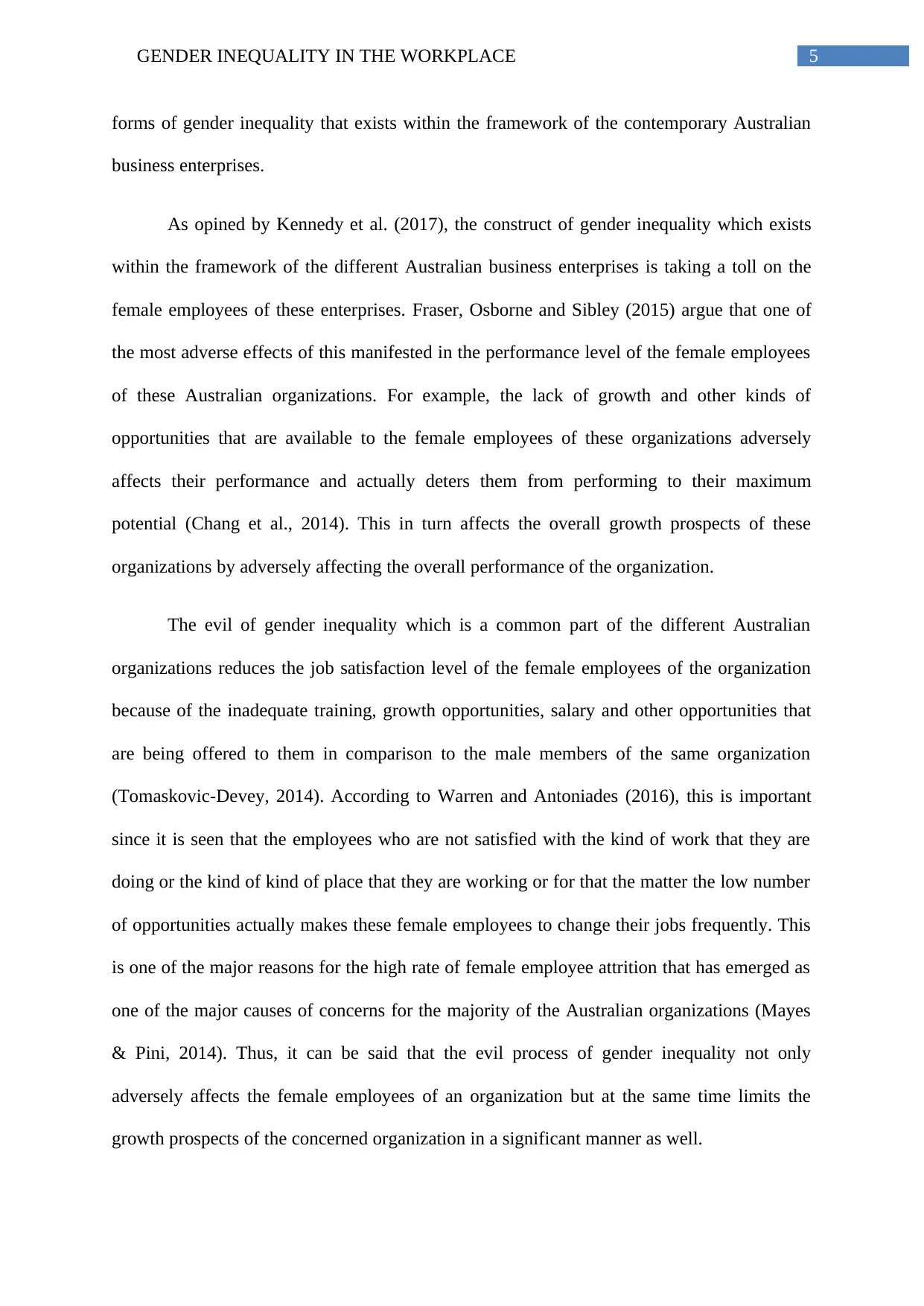
5GENDER INEQUALITY IN THE WORKPLACE
forms of gender inequality that exists within the framework of the contemporary Australian
business enterprises.
As opined by Kennedy et al. (2017), the construct of gender inequality which exists
within the framework of the different Australian business enterprises is taking a toll on the
female employees of these enterprises. Fraser, Osborne and Sibley (2015) argue that one of
the most adverse effects of this manifested in the performance level of the female employees
of these Australian organizations. For example, the lack of growth and other kinds of
opportunities that are available to the female employees of these organizations adversely
affects their performance and actually deters them from performing to their maximum
potential (Chang et al., 2014). This in turn affects the overall growth prospects of these
organizations by adversely affecting the overall performance of the organization.
The evil of gender inequality which is a common part of the different Australian
organizations reduces the job satisfaction level of the female employees of the organization
because of the inadequate training, growth opportunities, salary and other opportunities that
are being offered to them in comparison to the male members of the same organization
(Tomaskovic-Devey, 2014). According to Warren and Antoniades (2016), this is important
since it is seen that the employees who are not satisfied with the kind of work that they are
doing or the kind of kind of place that they are working or for that the matter the low number
of opportunities actually makes these female employees to change their jobs frequently. This
is one of the major reasons for the high rate of female employee attrition that has emerged as
one of the major causes of concerns for the majority of the Australian organizations (Mayes
& Pini, 2014). Thus, it can be said that the evil process of gender inequality not only
adversely affects the female employees of an organization but at the same time limits the
growth prospects of the concerned organization in a significant manner as well.
forms of gender inequality that exists within the framework of the contemporary Australian
business enterprises.
As opined by Kennedy et al. (2017), the construct of gender inequality which exists
within the framework of the different Australian business enterprises is taking a toll on the
female employees of these enterprises. Fraser, Osborne and Sibley (2015) argue that one of
the most adverse effects of this manifested in the performance level of the female employees
of these Australian organizations. For example, the lack of growth and other kinds of
opportunities that are available to the female employees of these organizations adversely
affects their performance and actually deters them from performing to their maximum
potential (Chang et al., 2014). This in turn affects the overall growth prospects of these
organizations by adversely affecting the overall performance of the organization.
The evil of gender inequality which is a common part of the different Australian
organizations reduces the job satisfaction level of the female employees of the organization
because of the inadequate training, growth opportunities, salary and other opportunities that
are being offered to them in comparison to the male members of the same organization
(Tomaskovic-Devey, 2014). According to Warren and Antoniades (2016), this is important
since it is seen that the employees who are not satisfied with the kind of work that they are
doing or the kind of kind of place that they are working or for that the matter the low number
of opportunities actually makes these female employees to change their jobs frequently. This
is one of the major reasons for the high rate of female employee attrition that has emerged as
one of the major causes of concerns for the majority of the Australian organizations (Mayes
& Pini, 2014). Thus, it can be said that the evil process of gender inequality not only
adversely affects the female employees of an organization but at the same time limits the
growth prospects of the concerned organization in a significant manner as well.
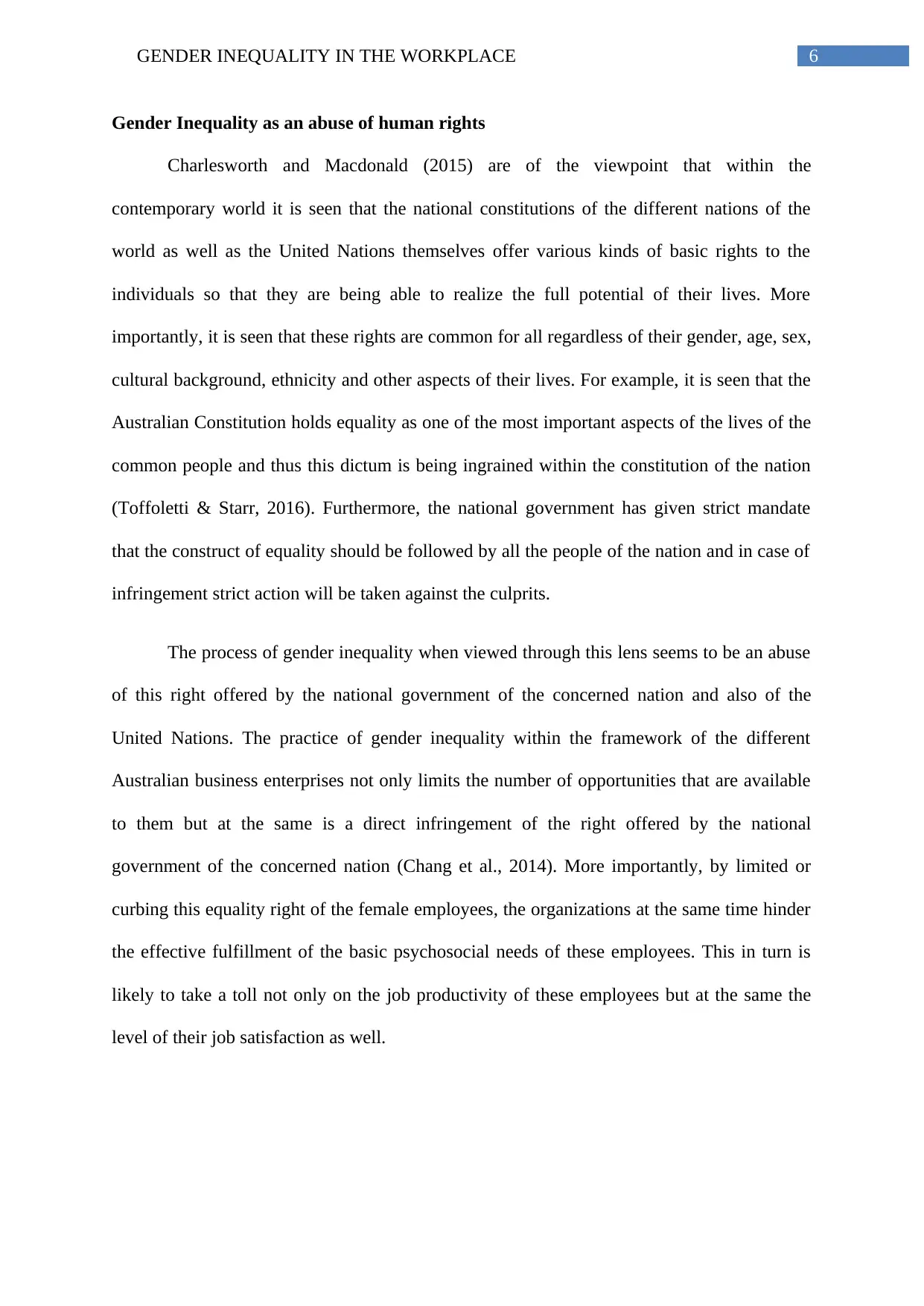
6GENDER INEQUALITY IN THE WORKPLACE
Gender Inequality as an abuse of human rights
Charlesworth and Macdonald (2015) are of the viewpoint that within the
contemporary world it is seen that the national constitutions of the different nations of the
world as well as the United Nations themselves offer various kinds of basic rights to the
individuals so that they are being able to realize the full potential of their lives. More
importantly, it is seen that these rights are common for all regardless of their gender, age, sex,
cultural background, ethnicity and other aspects of their lives. For example, it is seen that the
Australian Constitution holds equality as one of the most important aspects of the lives of the
common people and thus this dictum is being ingrained within the constitution of the nation
(Toffoletti & Starr, 2016). Furthermore, the national government has given strict mandate
that the construct of equality should be followed by all the people of the nation and in case of
infringement strict action will be taken against the culprits.
The process of gender inequality when viewed through this lens seems to be an abuse
of this right offered by the national government of the concerned nation and also of the
United Nations. The practice of gender inequality within the framework of the different
Australian business enterprises not only limits the number of opportunities that are available
to them but at the same is a direct infringement of the right offered by the national
government of the concerned nation (Chang et al., 2014). More importantly, by limited or
curbing this equality right of the female employees, the organizations at the same time hinder
the effective fulfillment of the basic psychosocial needs of these employees. This in turn is
likely to take a toll not only on the job productivity of these employees but at the same the
level of their job satisfaction as well.
Gender Inequality as an abuse of human rights
Charlesworth and Macdonald (2015) are of the viewpoint that within the
contemporary world it is seen that the national constitutions of the different nations of the
world as well as the United Nations themselves offer various kinds of basic rights to the
individuals so that they are being able to realize the full potential of their lives. More
importantly, it is seen that these rights are common for all regardless of their gender, age, sex,
cultural background, ethnicity and other aspects of their lives. For example, it is seen that the
Australian Constitution holds equality as one of the most important aspects of the lives of the
common people and thus this dictum is being ingrained within the constitution of the nation
(Toffoletti & Starr, 2016). Furthermore, the national government has given strict mandate
that the construct of equality should be followed by all the people of the nation and in case of
infringement strict action will be taken against the culprits.
The process of gender inequality when viewed through this lens seems to be an abuse
of this right offered by the national government of the concerned nation and also of the
United Nations. The practice of gender inequality within the framework of the different
Australian business enterprises not only limits the number of opportunities that are available
to them but at the same is a direct infringement of the right offered by the national
government of the concerned nation (Chang et al., 2014). More importantly, by limited or
curbing this equality right of the female employees, the organizations at the same time hinder
the effective fulfillment of the basic psychosocial needs of these employees. This in turn is
likely to take a toll not only on the job productivity of these employees but at the same the
level of their job satisfaction as well.
Paraphrase This Document
Need a fresh take? Get an instant paraphrase of this document with our AI Paraphraser
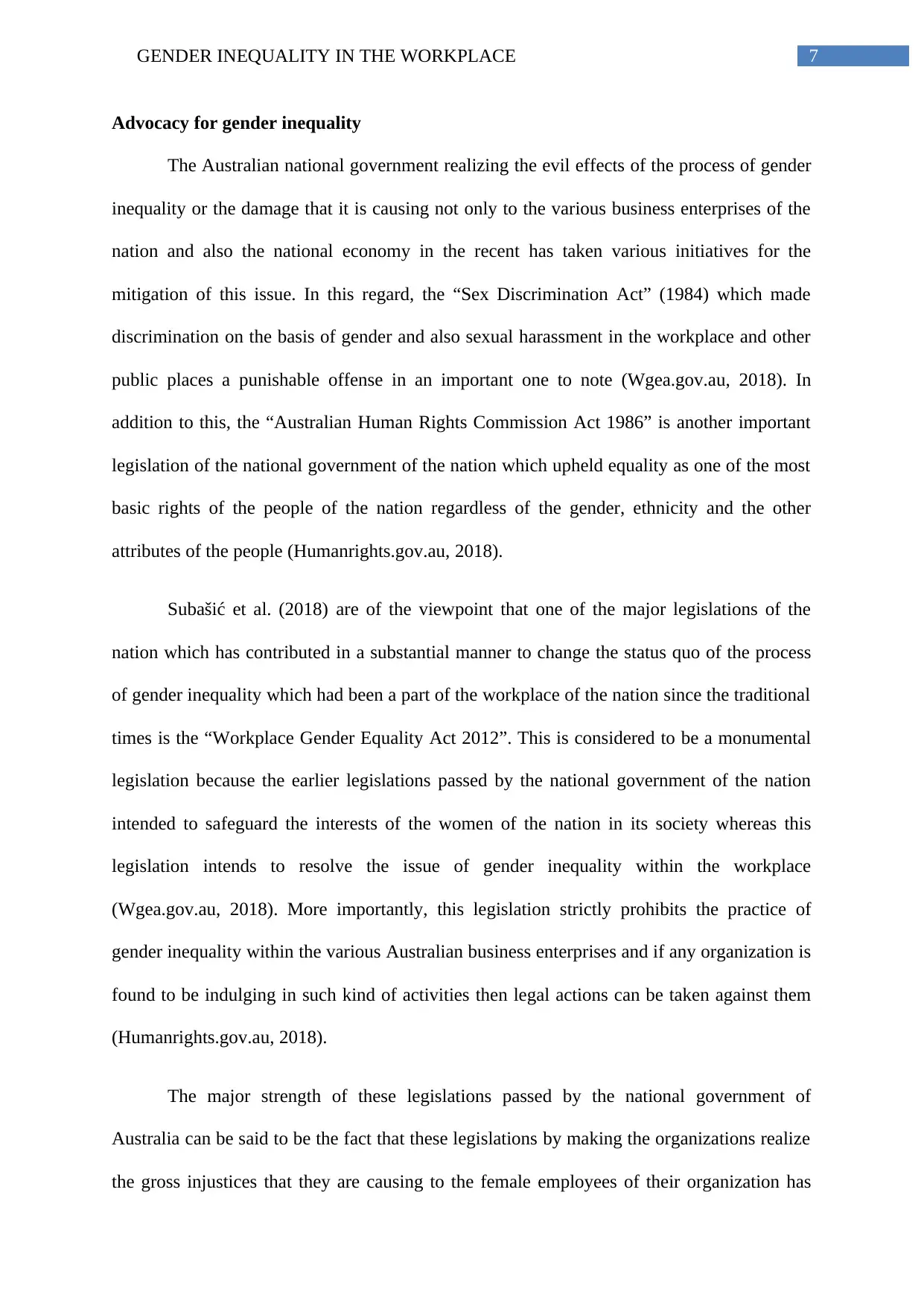
7GENDER INEQUALITY IN THE WORKPLACE
Advocacy for gender inequality
The Australian national government realizing the evil effects of the process of gender
inequality or the damage that it is causing not only to the various business enterprises of the
nation and also the national economy in the recent has taken various initiatives for the
mitigation of this issue. In this regard, the “Sex Discrimination Act” (1984) which made
discrimination on the basis of gender and also sexual harassment in the workplace and other
public places a punishable offense in an important one to note (Wgea.gov.au, 2018). In
addition to this, the “Australian Human Rights Commission Act 1986” is another important
legislation of the national government of the nation which upheld equality as one of the most
basic rights of the people of the nation regardless of the gender, ethnicity and the other
attributes of the people (Humanrights.gov.au, 2018).
Subašić et al. (2018) are of the viewpoint that one of the major legislations of the
nation which has contributed in a substantial manner to change the status quo of the process
of gender inequality which had been a part of the workplace of the nation since the traditional
times is the “Workplace Gender Equality Act 2012”. This is considered to be a monumental
legislation because the earlier legislations passed by the national government of the nation
intended to safeguard the interests of the women of the nation in its society whereas this
legislation intends to resolve the issue of gender inequality within the workplace
(Wgea.gov.au, 2018). More importantly, this legislation strictly prohibits the practice of
gender inequality within the various Australian business enterprises and if any organization is
found to be indulging in such kind of activities then legal actions can be taken against them
(Humanrights.gov.au, 2018).
The major strength of these legislations passed by the national government of
Australia can be said to be the fact that these legislations by making the organizations realize
the gross injustices that they are causing to the female employees of their organization has
Advocacy for gender inequality
The Australian national government realizing the evil effects of the process of gender
inequality or the damage that it is causing not only to the various business enterprises of the
nation and also the national economy in the recent has taken various initiatives for the
mitigation of this issue. In this regard, the “Sex Discrimination Act” (1984) which made
discrimination on the basis of gender and also sexual harassment in the workplace and other
public places a punishable offense in an important one to note (Wgea.gov.au, 2018). In
addition to this, the “Australian Human Rights Commission Act 1986” is another important
legislation of the national government of the nation which upheld equality as one of the most
basic rights of the people of the nation regardless of the gender, ethnicity and the other
attributes of the people (Humanrights.gov.au, 2018).
Subašić et al. (2018) are of the viewpoint that one of the major legislations of the
nation which has contributed in a substantial manner to change the status quo of the process
of gender inequality which had been a part of the workplace of the nation since the traditional
times is the “Workplace Gender Equality Act 2012”. This is considered to be a monumental
legislation because the earlier legislations passed by the national government of the nation
intended to safeguard the interests of the women of the nation in its society whereas this
legislation intends to resolve the issue of gender inequality within the workplace
(Wgea.gov.au, 2018). More importantly, this legislation strictly prohibits the practice of
gender inequality within the various Australian business enterprises and if any organization is
found to be indulging in such kind of activities then legal actions can be taken against them
(Humanrights.gov.au, 2018).
The major strength of these legislations passed by the national government of
Australia can be said to be the fact that these legislations by making the organizations realize
the gross injustices that they are causing to the female employees of their organization has
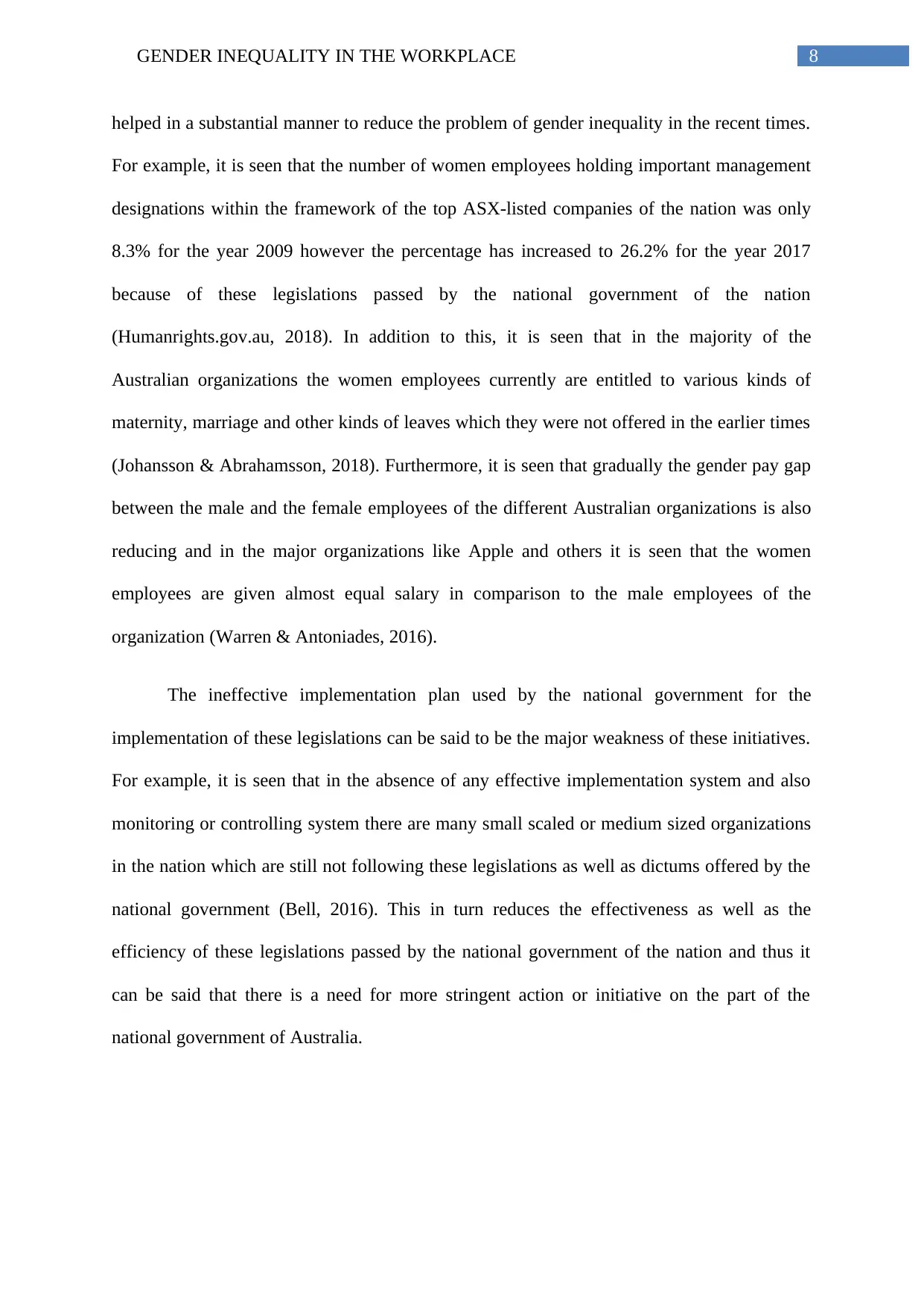
8GENDER INEQUALITY IN THE WORKPLACE
helped in a substantial manner to reduce the problem of gender inequality in the recent times.
For example, it is seen that the number of women employees holding important management
designations within the framework of the top ASX-listed companies of the nation was only
8.3% for the year 2009 however the percentage has increased to 26.2% for the year 2017
because of these legislations passed by the national government of the nation
(Humanrights.gov.au, 2018). In addition to this, it is seen that in the majority of the
Australian organizations the women employees currently are entitled to various kinds of
maternity, marriage and other kinds of leaves which they were not offered in the earlier times
(Johansson & Abrahamsson, 2018). Furthermore, it is seen that gradually the gender pay gap
between the male and the female employees of the different Australian organizations is also
reducing and in the major organizations like Apple and others it is seen that the women
employees are given almost equal salary in comparison to the male employees of the
organization (Warren & Antoniades, 2016).
The ineffective implementation plan used by the national government for the
implementation of these legislations can be said to be the major weakness of these initiatives.
For example, it is seen that in the absence of any effective implementation system and also
monitoring or controlling system there are many small scaled or medium sized organizations
in the nation which are still not following these legislations as well as dictums offered by the
national government (Bell, 2016). This in turn reduces the effectiveness as well as the
efficiency of these legislations passed by the national government of the nation and thus it
can be said that there is a need for more stringent action or initiative on the part of the
national government of Australia.
helped in a substantial manner to reduce the problem of gender inequality in the recent times.
For example, it is seen that the number of women employees holding important management
designations within the framework of the top ASX-listed companies of the nation was only
8.3% for the year 2009 however the percentage has increased to 26.2% for the year 2017
because of these legislations passed by the national government of the nation
(Humanrights.gov.au, 2018). In addition to this, it is seen that in the majority of the
Australian organizations the women employees currently are entitled to various kinds of
maternity, marriage and other kinds of leaves which they were not offered in the earlier times
(Johansson & Abrahamsson, 2018). Furthermore, it is seen that gradually the gender pay gap
between the male and the female employees of the different Australian organizations is also
reducing and in the major organizations like Apple and others it is seen that the women
employees are given almost equal salary in comparison to the male employees of the
organization (Warren & Antoniades, 2016).
The ineffective implementation plan used by the national government for the
implementation of these legislations can be said to be the major weakness of these initiatives.
For example, it is seen that in the absence of any effective implementation system and also
monitoring or controlling system there are many small scaled or medium sized organizations
in the nation which are still not following these legislations as well as dictums offered by the
national government (Bell, 2016). This in turn reduces the effectiveness as well as the
efficiency of these legislations passed by the national government of the nation and thus it
can be said that there is a need for more stringent action or initiative on the part of the
national government of Australia.
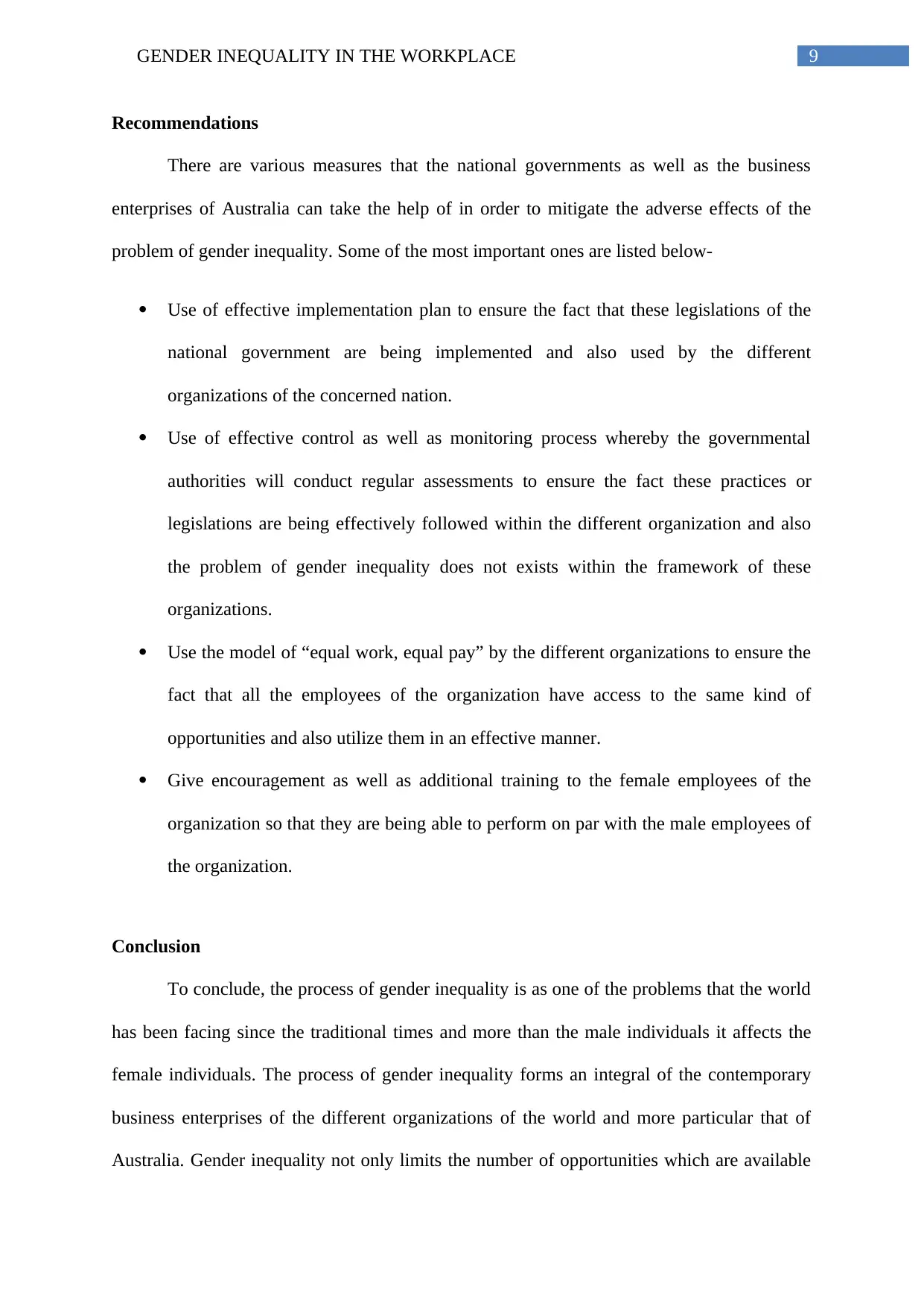
9GENDER INEQUALITY IN THE WORKPLACE
Recommendations
There are various measures that the national governments as well as the business
enterprises of Australia can take the help of in order to mitigate the adverse effects of the
problem of gender inequality. Some of the most important ones are listed below-
Use of effective implementation plan to ensure the fact that these legislations of the
national government are being implemented and also used by the different
organizations of the concerned nation.
Use of effective control as well as monitoring process whereby the governmental
authorities will conduct regular assessments to ensure the fact these practices or
legislations are being effectively followed within the different organization and also
the problem of gender inequality does not exists within the framework of these
organizations.
Use the model of “equal work, equal pay” by the different organizations to ensure the
fact that all the employees of the organization have access to the same kind of
opportunities and also utilize them in an effective manner.
Give encouragement as well as additional training to the female employees of the
organization so that they are being able to perform on par with the male employees of
the organization.
Conclusion
To conclude, the process of gender inequality is as one of the problems that the world
has been facing since the traditional times and more than the male individuals it affects the
female individuals. The process of gender inequality forms an integral of the contemporary
business enterprises of the different organizations of the world and more particular that of
Australia. Gender inequality not only limits the number of opportunities which are available
Recommendations
There are various measures that the national governments as well as the business
enterprises of Australia can take the help of in order to mitigate the adverse effects of the
problem of gender inequality. Some of the most important ones are listed below-
Use of effective implementation plan to ensure the fact that these legislations of the
national government are being implemented and also used by the different
organizations of the concerned nation.
Use of effective control as well as monitoring process whereby the governmental
authorities will conduct regular assessments to ensure the fact these practices or
legislations are being effectively followed within the different organization and also
the problem of gender inequality does not exists within the framework of these
organizations.
Use the model of “equal work, equal pay” by the different organizations to ensure the
fact that all the employees of the organization have access to the same kind of
opportunities and also utilize them in an effective manner.
Give encouragement as well as additional training to the female employees of the
organization so that they are being able to perform on par with the male employees of
the organization.
Conclusion
To conclude, the process of gender inequality is as one of the problems that the world
has been facing since the traditional times and more than the male individuals it affects the
female individuals. The process of gender inequality forms an integral of the contemporary
business enterprises of the different organizations of the world and more particular that of
Australia. Gender inequality not only limits the number of opportunities which are available
Secure Best Marks with AI Grader
Need help grading? Try our AI Grader for instant feedback on your assignments.
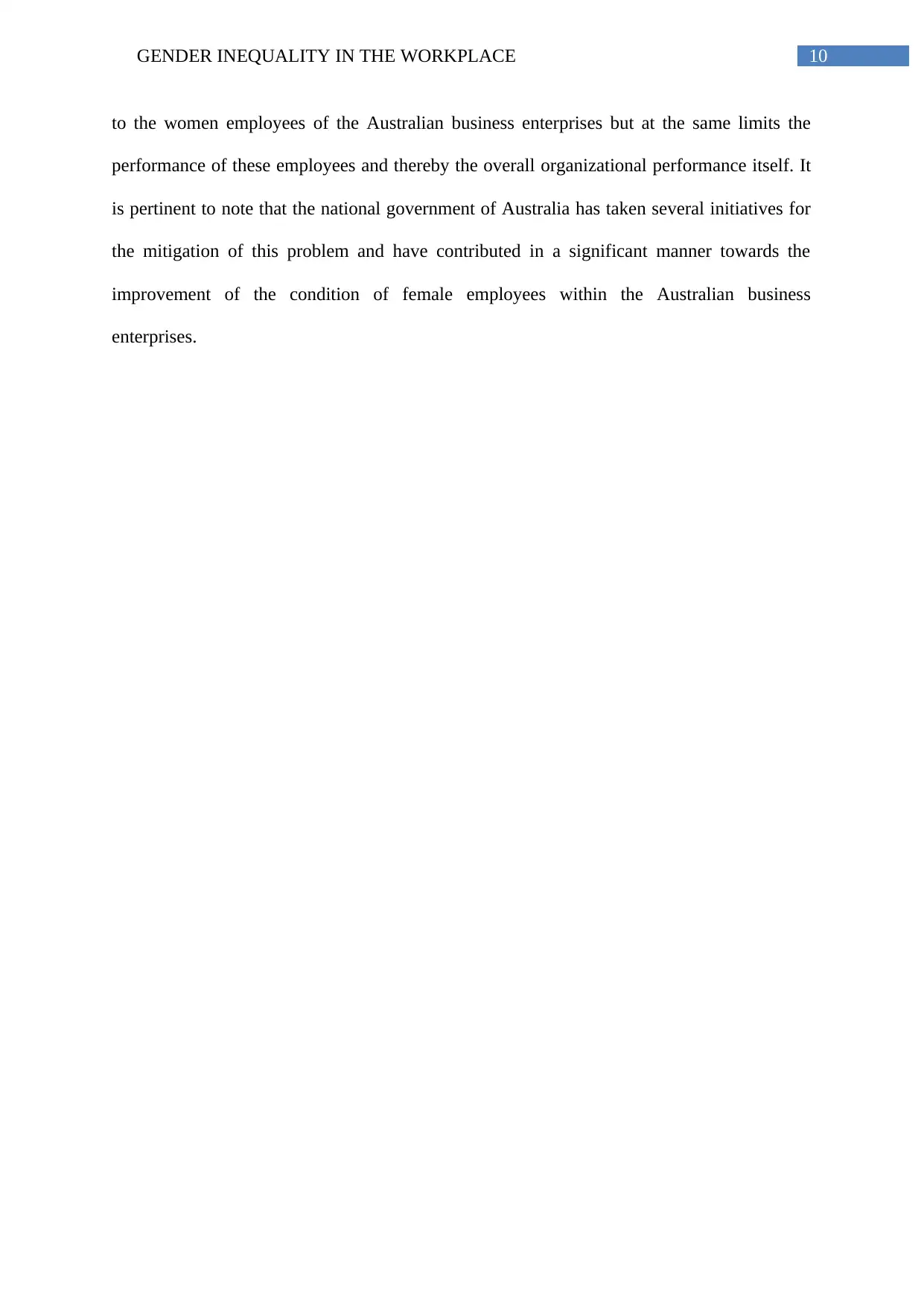
10GENDER INEQUALITY IN THE WORKPLACE
to the women employees of the Australian business enterprises but at the same limits the
performance of these employees and thereby the overall organizational performance itself. It
is pertinent to note that the national government of Australia has taken several initiatives for
the mitigation of this problem and have contributed in a significant manner towards the
improvement of the condition of female employees within the Australian business
enterprises.
to the women employees of the Australian business enterprises but at the same limits the
performance of these employees and thereby the overall organizational performance itself. It
is pertinent to note that the national government of Australia has taken several initiatives for
the mitigation of this problem and have contributed in a significant manner towards the
improvement of the condition of female employees within the Australian business
enterprises.
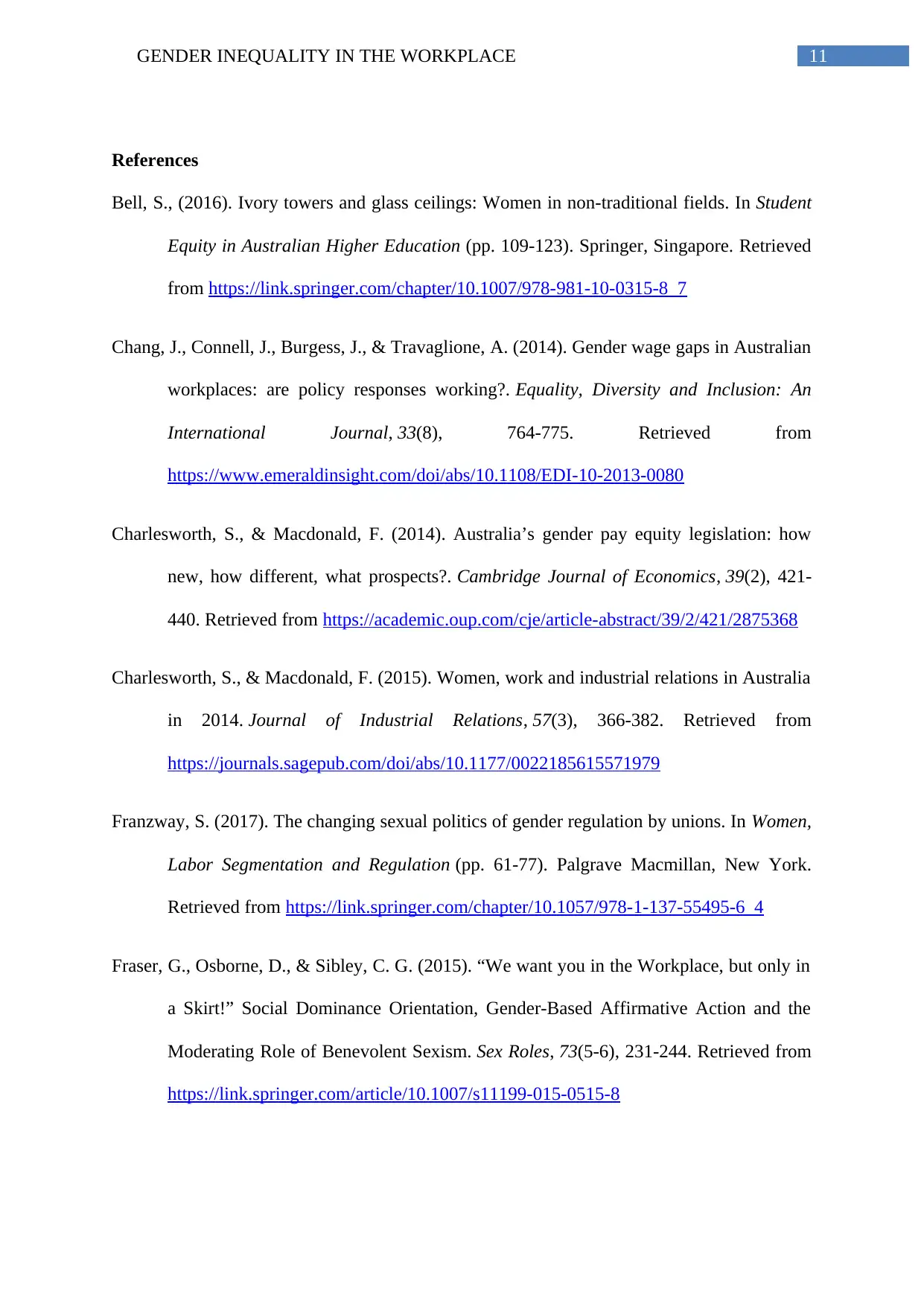
11GENDER INEQUALITY IN THE WORKPLACE
References
Bell, S., (2016). Ivory towers and glass ceilings: Women in non-traditional fields. In Student
Equity in Australian Higher Education (pp. 109-123). Springer, Singapore. Retrieved
from https://link.springer.com/chapter/10.1007/978-981-10-0315-8_7
Chang, J., Connell, J., Burgess, J., & Travaglione, A. (2014). Gender wage gaps in Australian
workplaces: are policy responses working?. Equality, Diversity and Inclusion: An
International Journal, 33(8), 764-775. Retrieved from
https://www.emeraldinsight.com/doi/abs/10.1108/EDI-10-2013-0080
Charlesworth, S., & Macdonald, F. (2014). Australia’s gender pay equity legislation: how
new, how different, what prospects?. Cambridge Journal of Economics, 39(2), 421-
440. Retrieved from https://academic.oup.com/cje/article-abstract/39/2/421/2875368
Charlesworth, S., & Macdonald, F. (2015). Women, work and industrial relations in Australia
in 2014. Journal of Industrial Relations, 57(3), 366-382. Retrieved from
https://journals.sagepub.com/doi/abs/10.1177/0022185615571979
Franzway, S. (2017). The changing sexual politics of gender regulation by unions. In Women,
Labor Segmentation and Regulation (pp. 61-77). Palgrave Macmillan, New York.
Retrieved from https://link.springer.com/chapter/10.1057/978-1-137-55495-6_4
Fraser, G., Osborne, D., & Sibley, C. G. (2015). “We want you in the Workplace, but only in
a Skirt!” Social Dominance Orientation, Gender-Based Affirmative Action and the
Moderating Role of Benevolent Sexism. Sex Roles, 73(5-6), 231-244. Retrieved from
https://link.springer.com/article/10.1007/s11199-015-0515-8
References
Bell, S., (2016). Ivory towers and glass ceilings: Women in non-traditional fields. In Student
Equity in Australian Higher Education (pp. 109-123). Springer, Singapore. Retrieved
from https://link.springer.com/chapter/10.1007/978-981-10-0315-8_7
Chang, J., Connell, J., Burgess, J., & Travaglione, A. (2014). Gender wage gaps in Australian
workplaces: are policy responses working?. Equality, Diversity and Inclusion: An
International Journal, 33(8), 764-775. Retrieved from
https://www.emeraldinsight.com/doi/abs/10.1108/EDI-10-2013-0080
Charlesworth, S., & Macdonald, F. (2014). Australia’s gender pay equity legislation: how
new, how different, what prospects?. Cambridge Journal of Economics, 39(2), 421-
440. Retrieved from https://academic.oup.com/cje/article-abstract/39/2/421/2875368
Charlesworth, S., & Macdonald, F. (2015). Women, work and industrial relations in Australia
in 2014. Journal of Industrial Relations, 57(3), 366-382. Retrieved from
https://journals.sagepub.com/doi/abs/10.1177/0022185615571979
Franzway, S. (2017). The changing sexual politics of gender regulation by unions. In Women,
Labor Segmentation and Regulation (pp. 61-77). Palgrave Macmillan, New York.
Retrieved from https://link.springer.com/chapter/10.1057/978-1-137-55495-6_4
Fraser, G., Osborne, D., & Sibley, C. G. (2015). “We want you in the Workplace, but only in
a Skirt!” Social Dominance Orientation, Gender-Based Affirmative Action and the
Moderating Role of Benevolent Sexism. Sex Roles, 73(5-6), 231-244. Retrieved from
https://link.springer.com/article/10.1007/s11199-015-0515-8
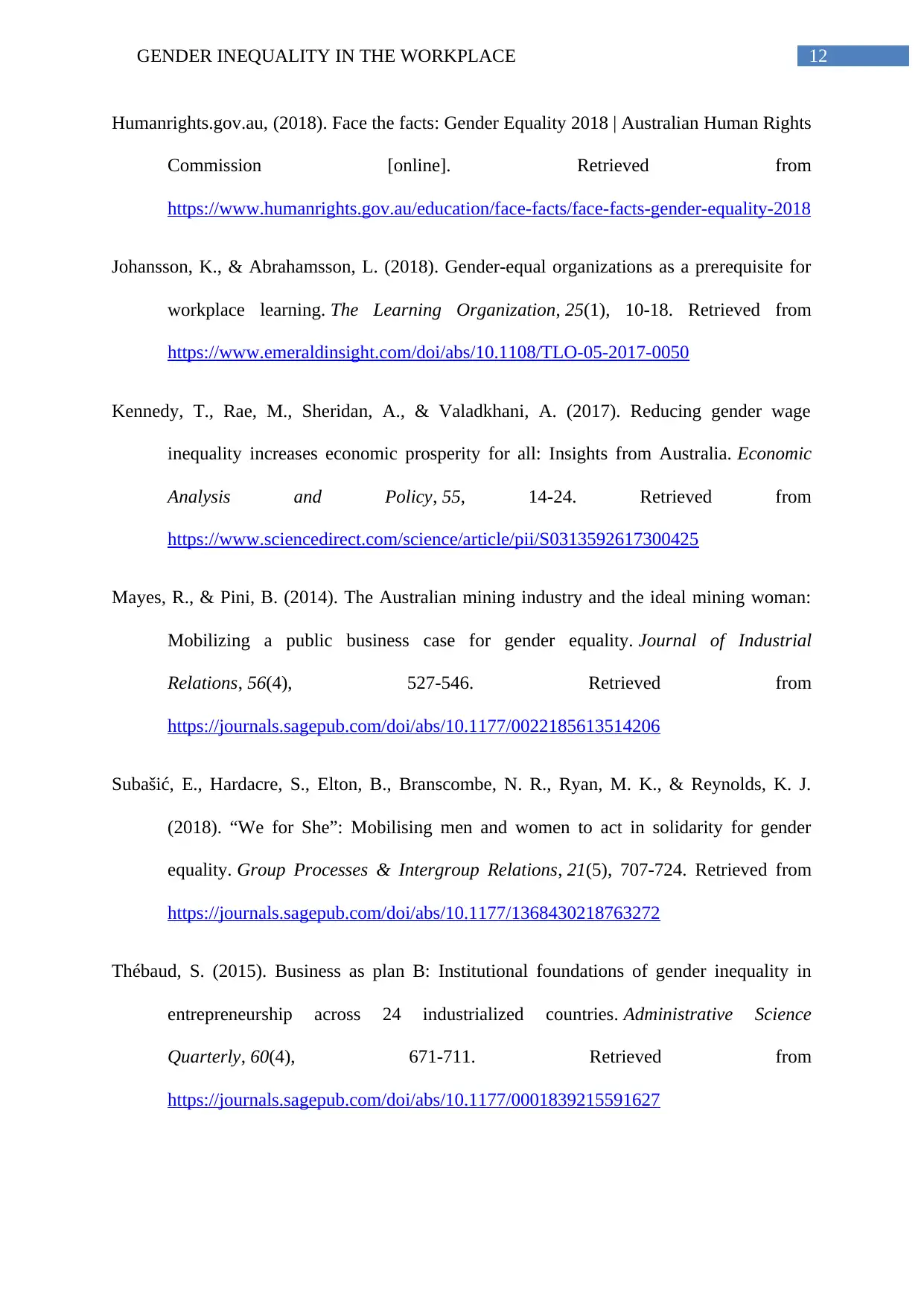
12GENDER INEQUALITY IN THE WORKPLACE
Humanrights.gov.au, (2018). Face the facts: Gender Equality 2018 | Australian Human Rights
Commission [online]. Retrieved from
https://www.humanrights.gov.au/education/face-facts/face-facts-gender-equality-2018
Johansson, K., & Abrahamsson, L. (2018). Gender-equal organizations as a prerequisite for
workplace learning. The Learning Organization, 25(1), 10-18. Retrieved from
https://www.emeraldinsight.com/doi/abs/10.1108/TLO-05-2017-0050
Kennedy, T., Rae, M., Sheridan, A., & Valadkhani, A. (2017). Reducing gender wage
inequality increases economic prosperity for all: Insights from Australia. Economic
Analysis and Policy, 55, 14-24. Retrieved from
https://www.sciencedirect.com/science/article/pii/S0313592617300425
Mayes, R., & Pini, B. (2014). The Australian mining industry and the ideal mining woman:
Mobilizing a public business case for gender equality. Journal of Industrial
Relations, 56(4), 527-546. Retrieved from
https://journals.sagepub.com/doi/abs/10.1177/0022185613514206
Subašić, E., Hardacre, S., Elton, B., Branscombe, N. R., Ryan, M. K., & Reynolds, K. J.
(2018). “We for She”: Mobilising men and women to act in solidarity for gender
equality. Group Processes & Intergroup Relations, 21(5), 707-724. Retrieved from
https://journals.sagepub.com/doi/abs/10.1177/1368430218763272
Thébaud, S. (2015). Business as plan B: Institutional foundations of gender inequality in
entrepreneurship across 24 industrialized countries. Administrative Science
Quarterly, 60(4), 671-711. Retrieved from
https://journals.sagepub.com/doi/abs/10.1177/0001839215591627
Humanrights.gov.au, (2018). Face the facts: Gender Equality 2018 | Australian Human Rights
Commission [online]. Retrieved from
https://www.humanrights.gov.au/education/face-facts/face-facts-gender-equality-2018
Johansson, K., & Abrahamsson, L. (2018). Gender-equal organizations as a prerequisite for
workplace learning. The Learning Organization, 25(1), 10-18. Retrieved from
https://www.emeraldinsight.com/doi/abs/10.1108/TLO-05-2017-0050
Kennedy, T., Rae, M., Sheridan, A., & Valadkhani, A. (2017). Reducing gender wage
inequality increases economic prosperity for all: Insights from Australia. Economic
Analysis and Policy, 55, 14-24. Retrieved from
https://www.sciencedirect.com/science/article/pii/S0313592617300425
Mayes, R., & Pini, B. (2014). The Australian mining industry and the ideal mining woman:
Mobilizing a public business case for gender equality. Journal of Industrial
Relations, 56(4), 527-546. Retrieved from
https://journals.sagepub.com/doi/abs/10.1177/0022185613514206
Subašić, E., Hardacre, S., Elton, B., Branscombe, N. R., Ryan, M. K., & Reynolds, K. J.
(2018). “We for She”: Mobilising men and women to act in solidarity for gender
equality. Group Processes & Intergroup Relations, 21(5), 707-724. Retrieved from
https://journals.sagepub.com/doi/abs/10.1177/1368430218763272
Thébaud, S. (2015). Business as plan B: Institutional foundations of gender inequality in
entrepreneurship across 24 industrialized countries. Administrative Science
Quarterly, 60(4), 671-711. Retrieved from
https://journals.sagepub.com/doi/abs/10.1177/0001839215591627
Paraphrase This Document
Need a fresh take? Get an instant paraphrase of this document with our AI Paraphraser
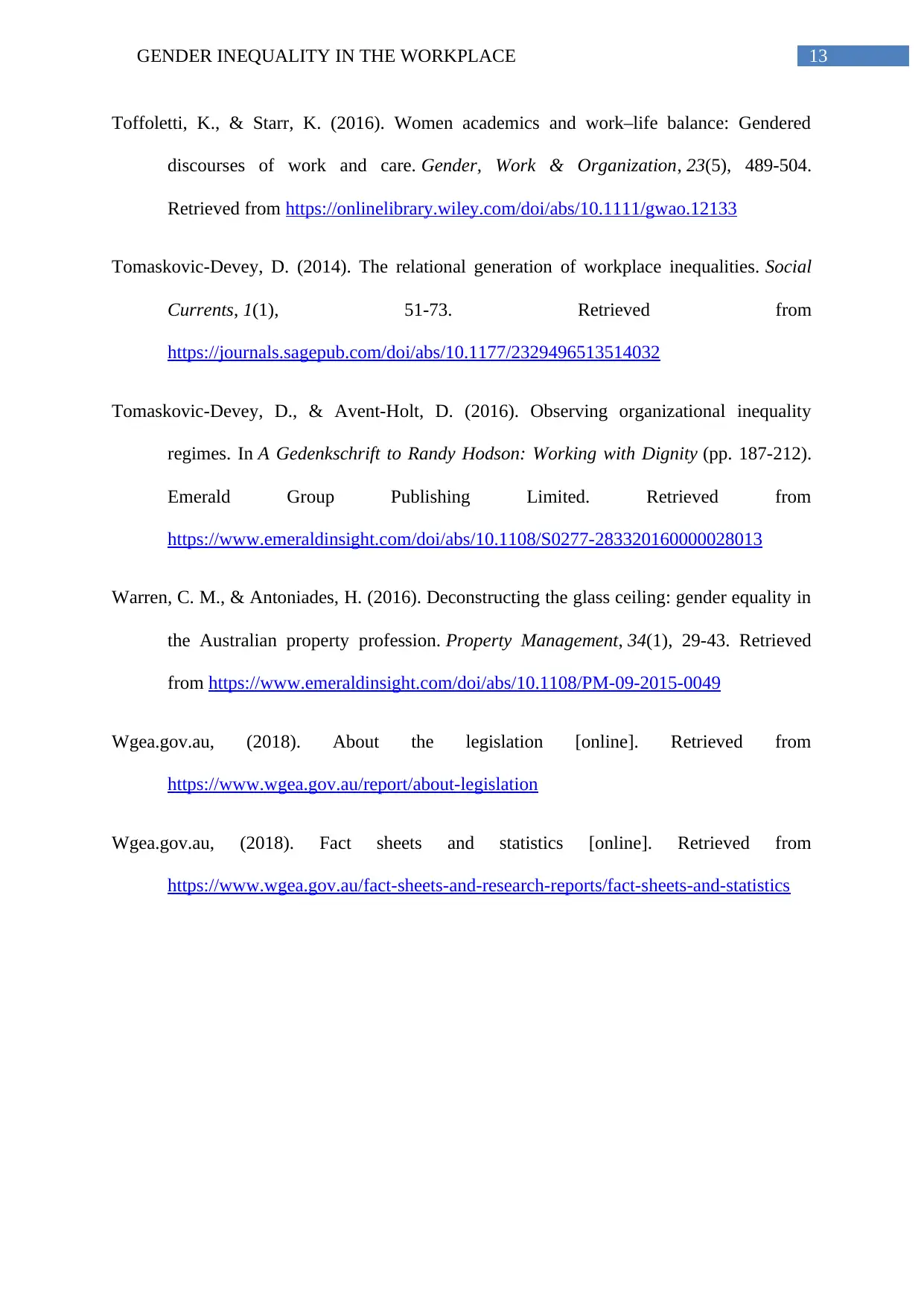
13GENDER INEQUALITY IN THE WORKPLACE
Toffoletti, K., & Starr, K. (2016). Women academics and work–life balance: Gendered
discourses of work and care. Gender, Work & Organization, 23(5), 489-504.
Retrieved from https://onlinelibrary.wiley.com/doi/abs/10.1111/gwao.12133
Tomaskovic-Devey, D. (2014). The relational generation of workplace inequalities. Social
Currents, 1(1), 51-73. Retrieved from
https://journals.sagepub.com/doi/abs/10.1177/2329496513514032
Tomaskovic-Devey, D., & Avent-Holt, D. (2016). Observing organizational inequality
regimes. In A Gedenkschrift to Randy Hodson: Working with Dignity (pp. 187-212).
Emerald Group Publishing Limited. Retrieved from
https://www.emeraldinsight.com/doi/abs/10.1108/S0277-283320160000028013
Warren, C. M., & Antoniades, H. (2016). Deconstructing the glass ceiling: gender equality in
the Australian property profession. Property Management, 34(1), 29-43. Retrieved
from https://www.emeraldinsight.com/doi/abs/10.1108/PM-09-2015-0049
Wgea.gov.au, (2018). About the legislation [online]. Retrieved from
https://www.wgea.gov.au/report/about-legislation
Wgea.gov.au, (2018). Fact sheets and statistics [online]. Retrieved from
https://www.wgea.gov.au/fact-sheets-and-research-reports/fact-sheets-and-statistics
Toffoletti, K., & Starr, K. (2016). Women academics and work–life balance: Gendered
discourses of work and care. Gender, Work & Organization, 23(5), 489-504.
Retrieved from https://onlinelibrary.wiley.com/doi/abs/10.1111/gwao.12133
Tomaskovic-Devey, D. (2014). The relational generation of workplace inequalities. Social
Currents, 1(1), 51-73. Retrieved from
https://journals.sagepub.com/doi/abs/10.1177/2329496513514032
Tomaskovic-Devey, D., & Avent-Holt, D. (2016). Observing organizational inequality
regimes. In A Gedenkschrift to Randy Hodson: Working with Dignity (pp. 187-212).
Emerald Group Publishing Limited. Retrieved from
https://www.emeraldinsight.com/doi/abs/10.1108/S0277-283320160000028013
Warren, C. M., & Antoniades, H. (2016). Deconstructing the glass ceiling: gender equality in
the Australian property profession. Property Management, 34(1), 29-43. Retrieved
from https://www.emeraldinsight.com/doi/abs/10.1108/PM-09-2015-0049
Wgea.gov.au, (2018). About the legislation [online]. Retrieved from
https://www.wgea.gov.au/report/about-legislation
Wgea.gov.au, (2018). Fact sheets and statistics [online]. Retrieved from
https://www.wgea.gov.au/fact-sheets-and-research-reports/fact-sheets-and-statistics
1 out of 14
Related Documents
Your All-in-One AI-Powered Toolkit for Academic Success.
+13062052269
info@desklib.com
Available 24*7 on WhatsApp / Email
![[object Object]](/_next/static/media/star-bottom.7253800d.svg)
Unlock your academic potential
© 2024 | Zucol Services PVT LTD | All rights reserved.




